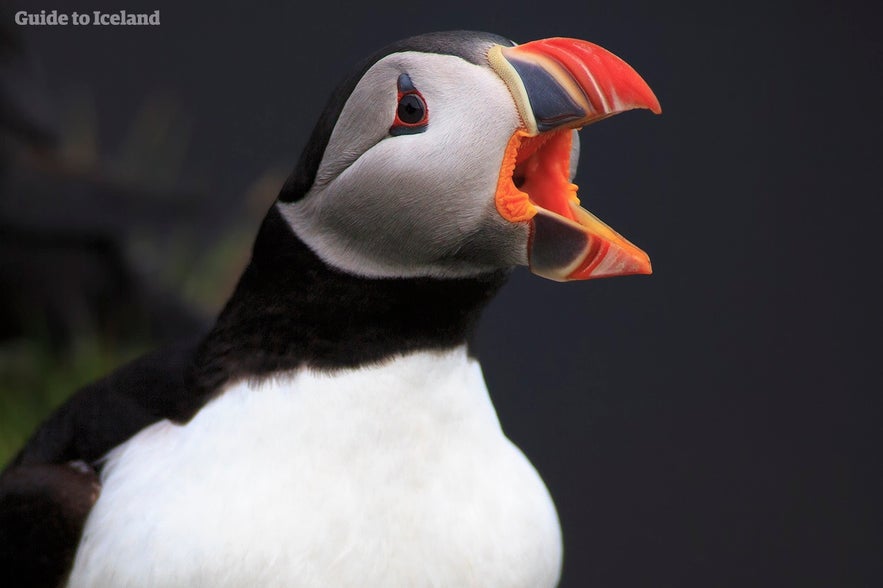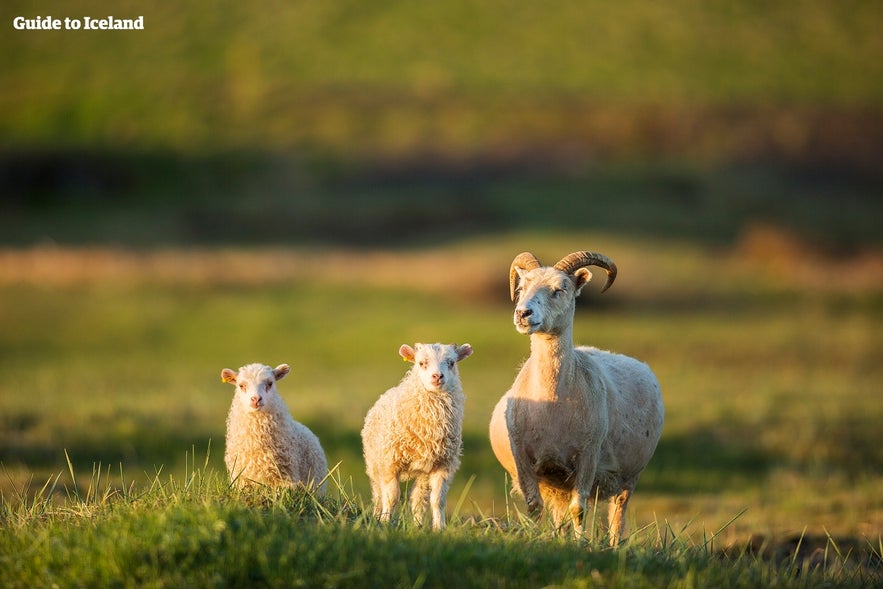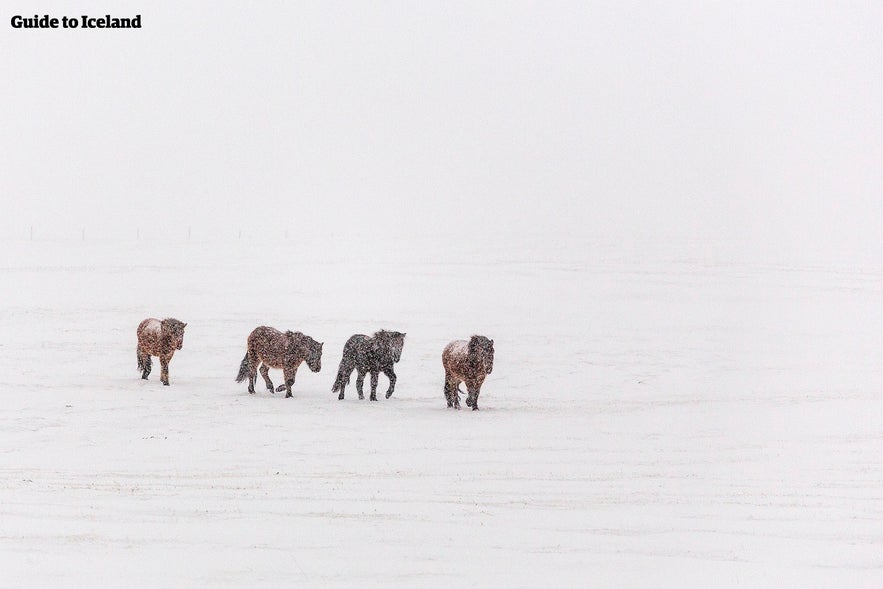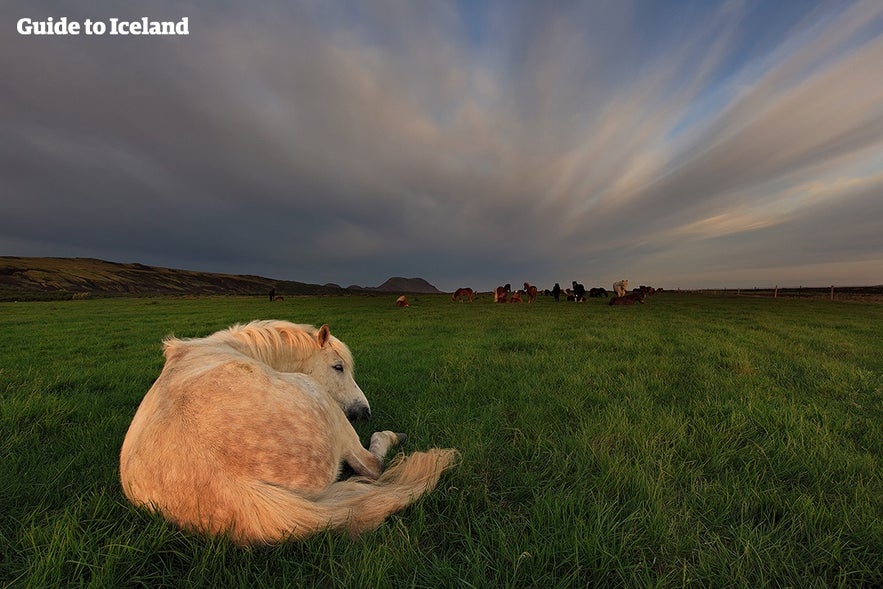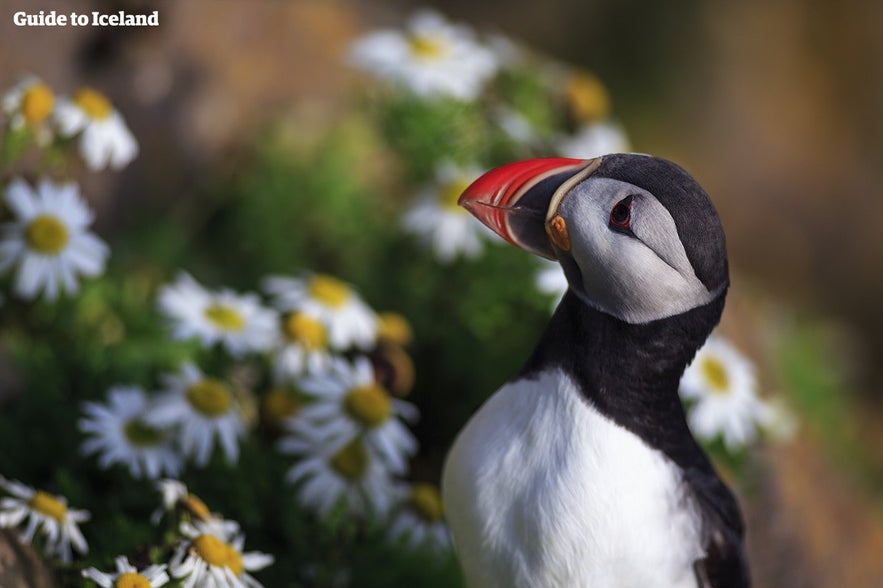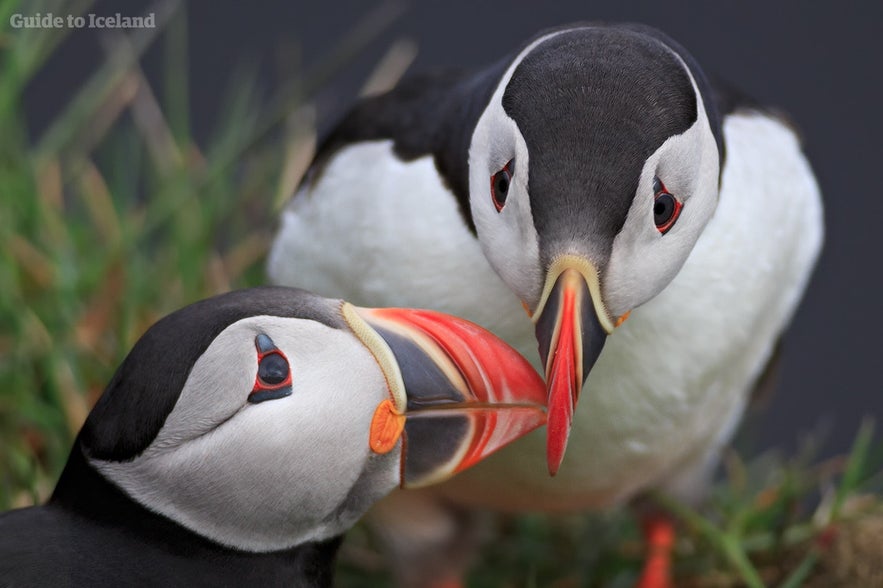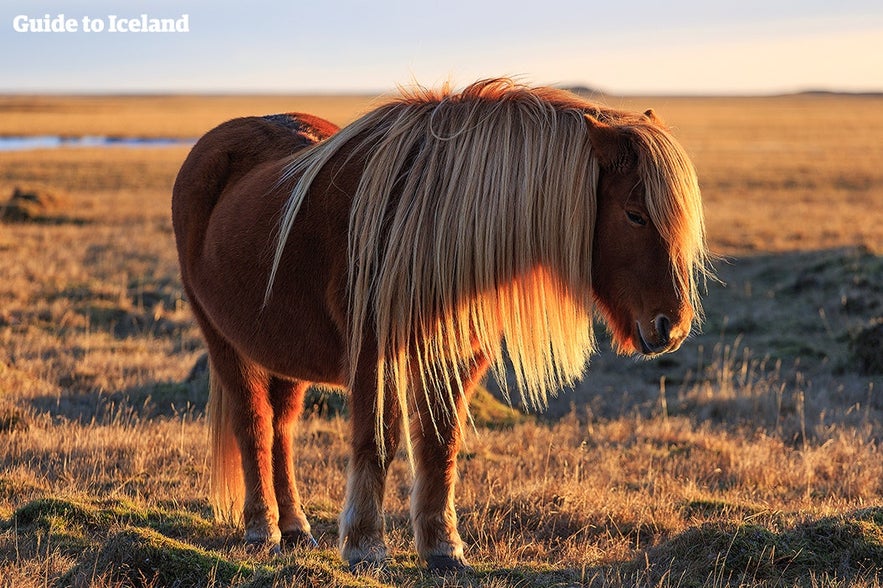
Wildlife and Animals in Iceland: The Complete Guide

- Domestic Animals in Iceland
- The Icelandic Sheep
- The Icelandic Sheepdog
- The Icelandic Horse
- Cattle in Iceland
- Non-Native Wildlife in Iceland
- Reindeer in East Iceland
- Rodents and Mink in Iceland
- Native Wildlife in Iceland
- Arctic Foxes of Iceland
- Whales of Iceland
- Seals of Iceland
- Puffins of Iceland
- Other Birds of Iceland
- Polar Bears from Greenland
Learn all about Iceland wildlife in our detailed guide. Despite being a stark, volcanic land with little vegetation, Icelandic wildlife and animals have evolved and adapted to the conditions. Discover animals native to Iceland, including those that contribute to the country’s distinct national character. Read ahead to learn about the animals of Iceland.
Before humans settled Iceland in the 9th century, it had but one land mammal, the Arctic fox. The rest of the creatures were either birds or marine animals. However, a millennium later, a wealth of life has adapted to the harsh climate.
From its unique domestic livestock, which quite literally kept Icelanders alive during their most trying times, to the creatures that have escaped captivity and formed a wild population, the animals of Iceland are thriving. They’re part of what pulls guests here from around the world.
You can book a variety of wildlife tours to enhance your experience, offering a closer look at Iceland’s animals and their habitats. Some animals cannot be found in Iceland's capital area, so it could be a good option to rent a car. Read ahead to explore the fascinating creatures that make up Iceland's wildlife.
Domestic Animals in Iceland
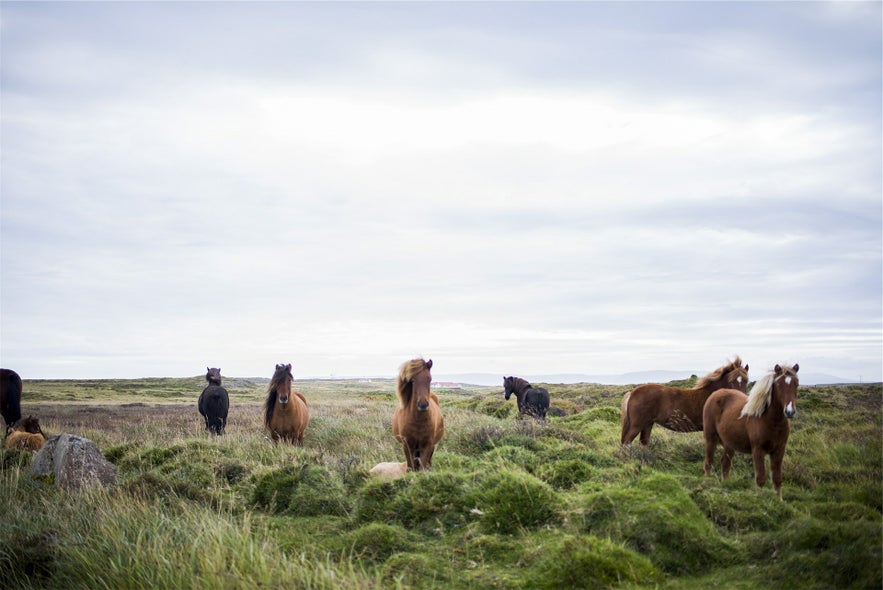 The vast majority of animals in Iceland that you’ll see are domestic. After all, this is a nation that relies heavily on agriculture.
The vast majority of animals in Iceland that you’ll see are domestic. After all, this is a nation that relies heavily on agriculture.
Though farm animals might not seem fascinating at first, their remarkable adaptation to Iceland's harsh climate and their crucial roles in the country’s history have made them essential to human survival. These resilient creatures have supported Icelanders through tough times, showcasing their unique importance to the nation’s heritage and way of life
The Icelandic Sheep
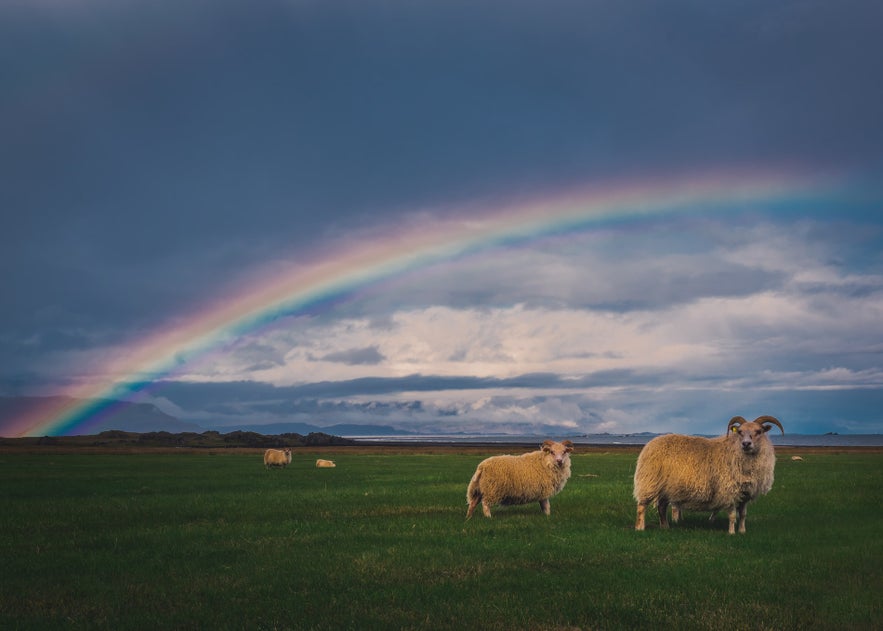 Photo by Cosmic Timetraveller
Photo by Cosmic Timetraveller
The Icelandic Sheep were the lifeblood of Iceland for centuries. The first settlers from Norway brought them to the island, and their wool and meat helped humans survive Iceland’s harsh conditions.
While not being the most exciting animals in Iceland, their role in the country’s history has been incredibly significant. Whenever the nation has gone through terrible struggles or a surge in growth, it has always returned to sheep.
For example, the 1783 eruption of the volcano Laki was the most fatal in the country’s history.
Up to 25 percent of the population died, primarily because of famine caused by the 80 percent of the nation’s sheep lost to the ash’s poisons.
On the other hand, Iceland’s significant growth and industrialization during World War One were also due to these creatures.
With the European countryside ravaged by war, Icelandic wool was in high demand. The wealth that came from sheep products during these four years helped propel Iceland into becoming the modern nation it is today. There are approximately 800,000 sheep in Iceland, more than double the number of people.
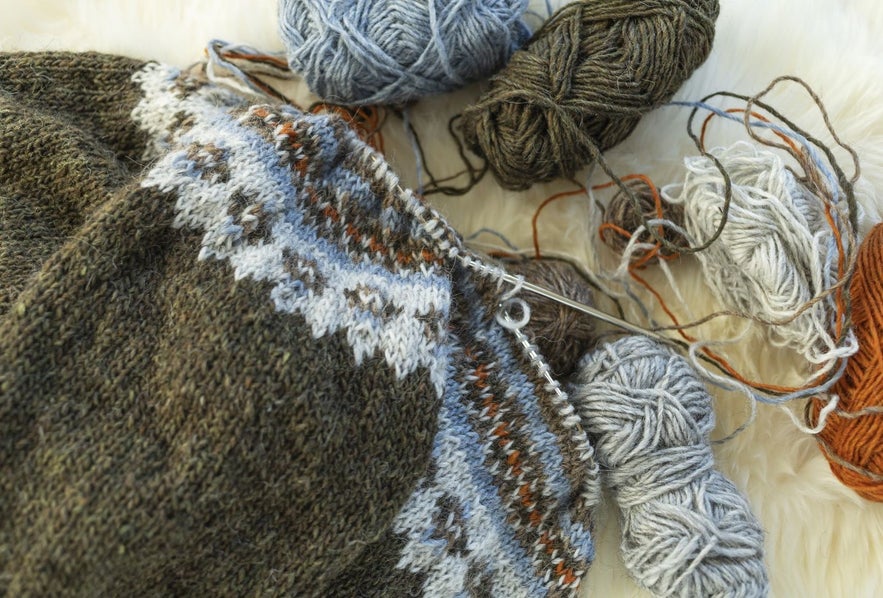 Their wool is used to create unique handicrafts, such as the Icelandic sweater, otherwise called “Lopapeysa.” The lopapeysa is an ideal layering piece, providing warmth and protection from the elements. It’s especially perfect for winter activities in Iceland. To get your hands on an authentic lopapeysa, visit the Handknitting Association on Skolavordustigur.
Their wool is used to create unique handicrafts, such as the Icelandic sweater, otherwise called “Lopapeysa.” The lopapeysa is an ideal layering piece, providing warmth and protection from the elements. It’s especially perfect for winter activities in Iceland. To get your hands on an authentic lopapeysa, visit the Handknitting Association on Skolavordustigur.
Many of Reykjavik’s Best Restaurants incorporate lamb into their dishes, as it’s a staple in Icelandic cuisine outside of fish dishes. The nation’s iconic lamb soup, in particular, is celebrated worldwide for its rich, hearty flavor.
The reason Icelandic lamb tastes as delicious as it does is rather morbid. The sheep are free-roaming throughout summer, and they graze on Icelandic thyme, unwittingly flavoring their meat while they’re still alive.
- Learn more about Icelandic Food
- Check out The 10 Weirdest Things about Icelandic People & Culture
The Icelandic Sheepdog
 Photo by Ulf Bodin
Photo by Ulf Bodin
Like the livestock of Iceland, Icelandic sheepdogs developed from their Nordic cousins when brought to Iceland by early settlers hundreds of years ago.
Since then, they have been essential in aiding farmers, herding, and guarding property.
Like most animals brought to Iceland, they’re smaller than their relatives abroad. They’re also much more susceptible to disease due to Iceland’s isolation, to the extent that they faced extinction from the late 19th century.
After a ban of other dog breeds entering the country and later pet vaccines and modern veterinary care that made this first step redundant, the population has recovered.
Other than their size, Icelandic sheepdogs share the same fluffy coat and curled tails as other sheepdog breeds.
They also share the same behavior. The sheepdogs are highly energetic, resilient, agile, and friendly, making them great companions for those with the time and space to let them exercise.
The vast majority of individuals live out in the country, where they can utilize their high energy and natural herding instincts to help their owners.
The Icelandic Horse
Icelandic horses are not at all like other breeds. At first sight, it appears that they only differ in terms of height, as they rarely reach 59 inches (150 centimeters) tall.
After a few minutes in their company, however, it becomes apparent that Icelandic horses are more friendly, curious, and intelligent than other horses. These character traits have made them a central part of Icelandic identity.
The reason for their unique charm is due to their descendants. Only one horse could fit within a longboat when Iceland was first settled.
Since many of the early settlers were wealthy chieftains, they would only take the very best of their stock with them. That meant that, as the settlement period ended, Iceland had a healthy population of the sturdiest, strongest, and most intelligent horses from Norway.
Icelandic horses are not particularly concerned by Iceland's winter weather. Initially, the horses were almost solely used for transportation and sometimes battles between clans. Over the centuries, however, they were used more and more for farm work and became central to the nation's survival.
Those in possession of a horse were able to travel from the country to the towns and trading posts, allowing them to develop more wealth and opportunity. Those without one were left isolated and more impoverished as a result.
As equestrian sports became more and more popular, Icelandic horses became noted for something else - while most breeds around the world have three or four “gaits” (style of walking, such as the trot and gallop), Icelandic horses had five.
Their unique gait, the "skeið," is a style that developed due to Iceland’s rough terrain and is noted for being comfortable with the potential for rapid acceleration.
For an unforgettable experience, you can book horseback riding tours and try this gait firsthand as you explore Iceland's stunning landscapes on the iconic Icelandic horse.
- Learn more about the Enchanting Gaits of The Icelandic Horse
- See more about Icelandic horseback riding
Icelandic horses are popular for dressage, riding, and their meat. Icelandic horses have become very popular in dressage because of their character, appearance, and unique qualities. More Icelandic horses now live outside the country than inside; 100,000 live abroad, compared to the 80,000 living domestically.
Those who leave Iceland can never return, and no other breeds are allowed on the island. These restrictions are because the isolated native breed is susceptible to diseases, and a foreign infection could cripple the whole population.
Riding an Icelandic horse is as near to an essential Icelandic experience as there is. There’s a wealth of horse-riding tours across Iceland. Because they usually only last a few hours, combining this excursion with many others, such as snorkeling, caving, or sightseeing around the Golden Circle, is possible.
Cattle in Iceland
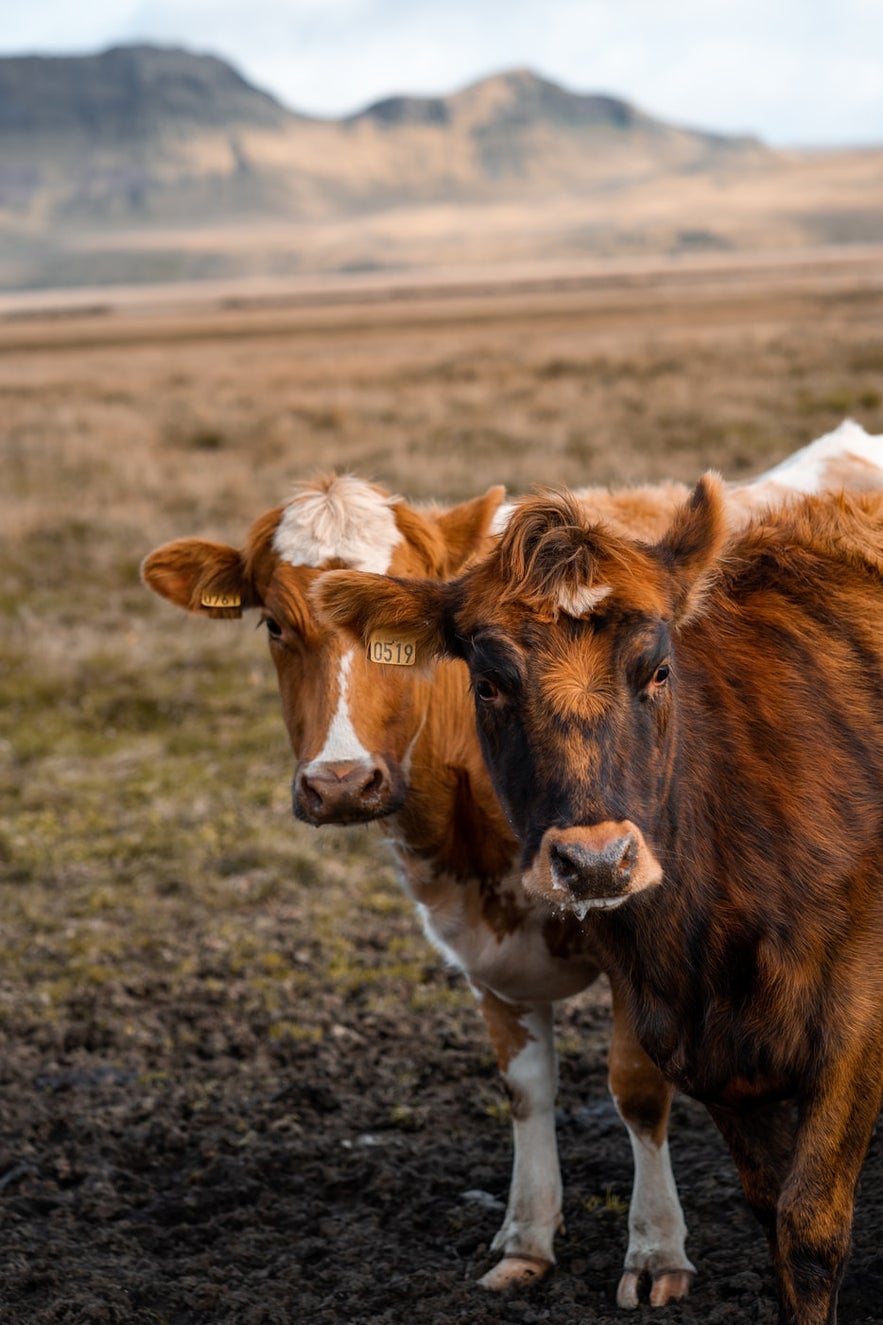 Photo by Kristoffer Jensen
Photo by Kristoffer Jensen
A less commonly seen farm animal in Iceland is the cow, but the country does have a unique breed. However, you might be able to spot them on a self-drive tour or by simply renting a car.
Like the horses, Icelandic cattle were brought over with Norway’s earliest settlers and have since developed unique traits. They are, for example, smaller than their European counterparts and very susceptible to foreign diseases.
Unfortunately, while Icelandic horses’ other qualities compare favorably to similar breeds worldwide, the qualities of Icelandic cattle do not. The Agricultural University of Iceland recently released a study saying that Swedish cows would produce more milk at a lower cost than the native breed and suggested that making the switch would benefit the economy.
Although the Icelandic population is not as connected to their cows as to their horses, there was still resistance to this idea.
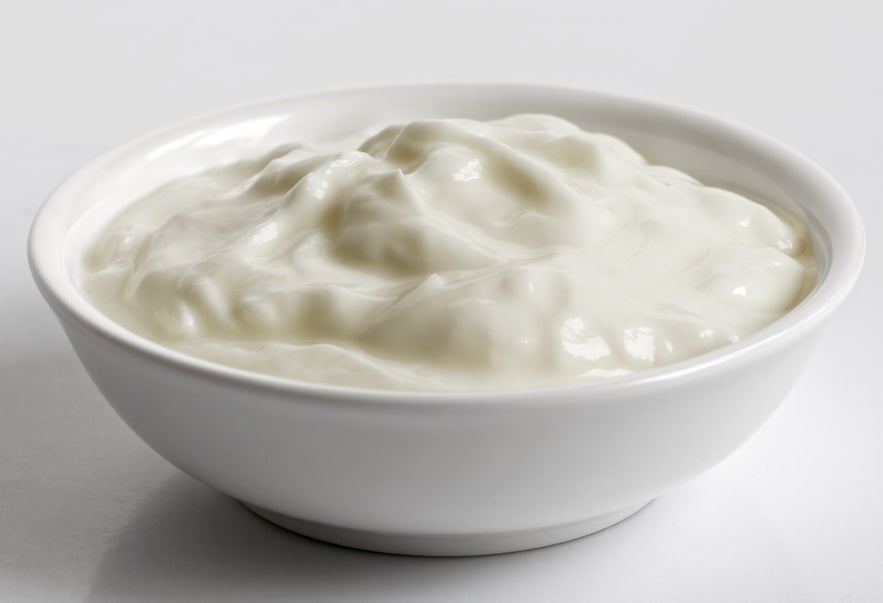
For a millennium, Icelandic cattle have produced essential dairy products, many of which have become an integral part of the nation’s culture. One particularly notable example is Skyr, a thick, yogurt-like cheese. For this reason, many consider them too crucial to Icelandic heritage to desert. The cows are also favored for their diverse colorations and patterns.
You can enjoy authentic Icelandic skyr at Erpsstaðir and Efstidalur Farm, where you can also meet the cows that produce the milk for this traditional treat.
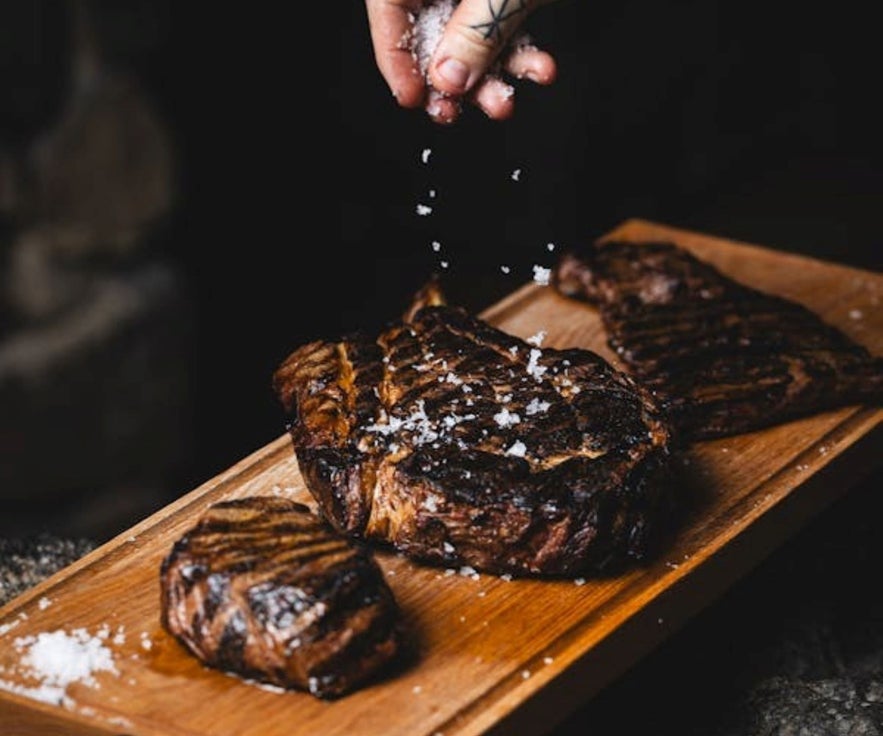
Iceland has been developing premium Angus beef, with Miðey Farm leading in quality production. For a taste of this local Angus beef, you can visit The Grillmarket in Reykjavik, where Miðey’s high-quality meat is featured in their dishes. Alongside their Angus beef options, the restaurant features other creative dishes made from locally sourced Icelandic ingredients, celebrating the country’s fresh, seasonal produce.
- Learn more about what Skyr is and How It Is Made
- See the Best Farms You Can Visit in Iceland
Non-Native Wildlife in Iceland
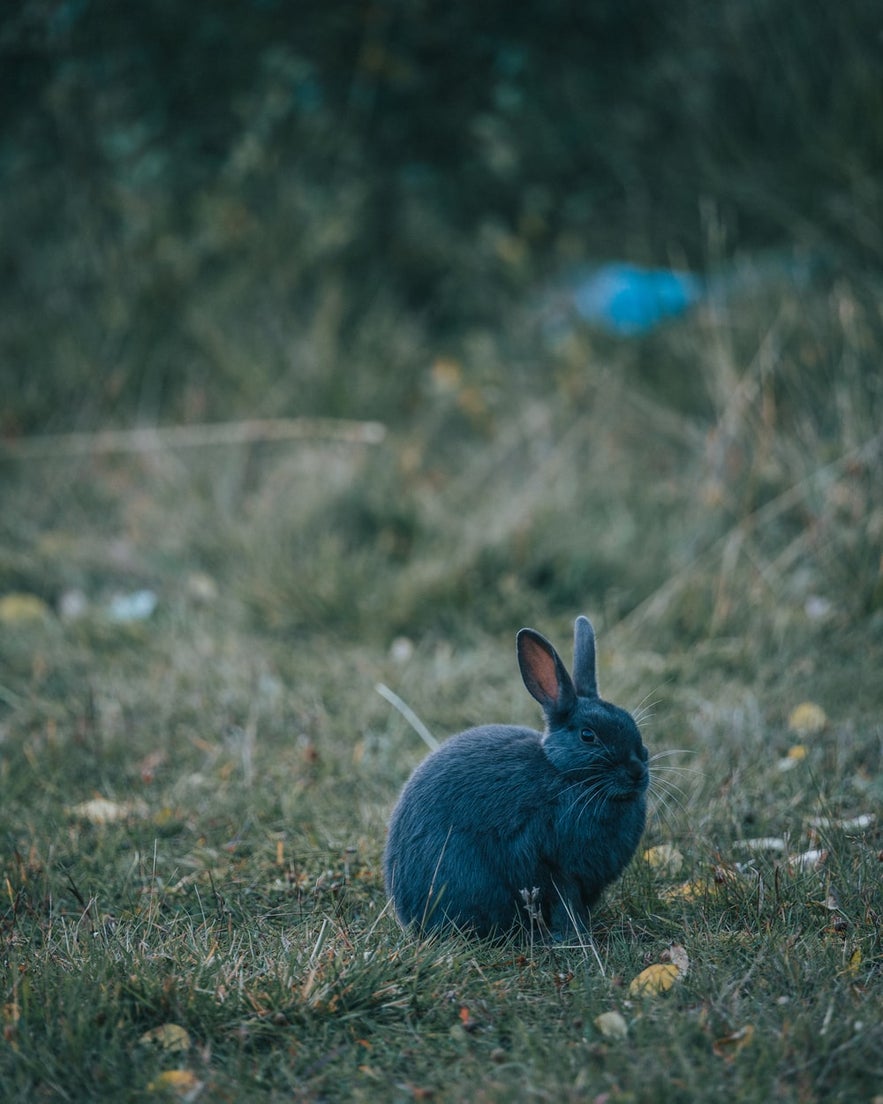 Photo by Tamas Tuzes-Katai
Photo by Tamas Tuzes-Katai
Iceland only had one native land animal when the Norse first arrived here. Today, there are multiple species to be found across the country.
None arrived naturally, either being brought over by humans or sneaking across on boats, but all have established themselves successfully, for better or worse.
Reindeer in East Iceland
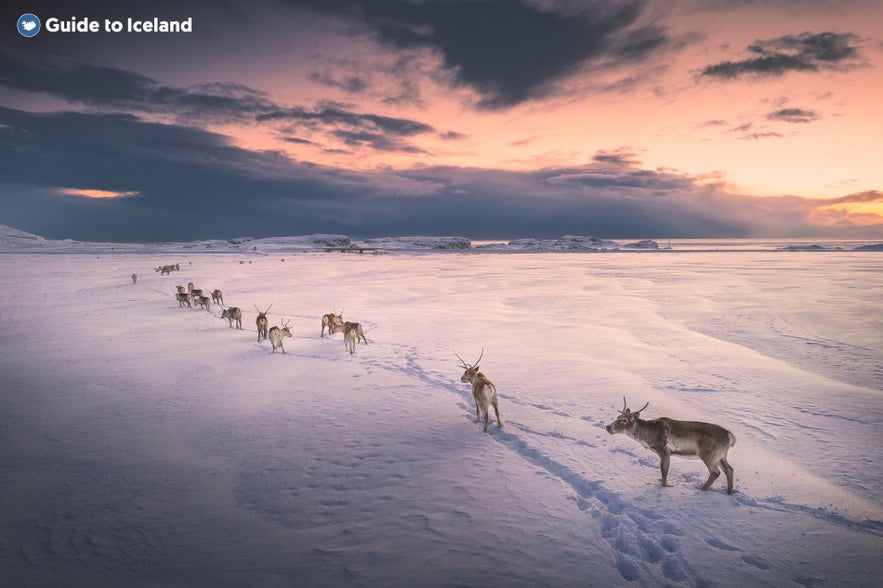
Reindeer in East Iceland are a common sight. Staying at hotels in East Iceland offers a peaceful base for exploring the region’s stunning landscapes, with the added benefit of reindeer sightings.
Reindeer were brought over to Iceland much later than domestic animals in the 18th century. Initially, they were supposed to be farmed as they were across Scandinavia, but Icelanders never took to the practice. The population, therefore, became wild.
About 3,000 reindeer now live in the country, concentrated in the East. The reindeer are most commonly found around Snaefell, on the higher ground throughout summer and in the warmer lowlands through winter. Still, they have been seen as far south as Jokulsarlon and as far north as Vopnafjordur.
Ideal for nature lovers and photography enthusiasts, a Guided Reindeer Safari offers the chance to experience Iceland’s unique wildlife and landscapes up close, with a good opportunity to spot a reindeer herd in their natural habitat.
While the reindeer are well-loved across Iceland, their population is controlled seasonally, as it is a concern that they may take food away from the grazing lands used by the free-roaming sheep.
This consumption would cause significant damage to the economy in the case of a brutal winter or a large-scale volcanic eruption, both of which are not uncommon in Iceland.
Rodents and Mink in Iceland
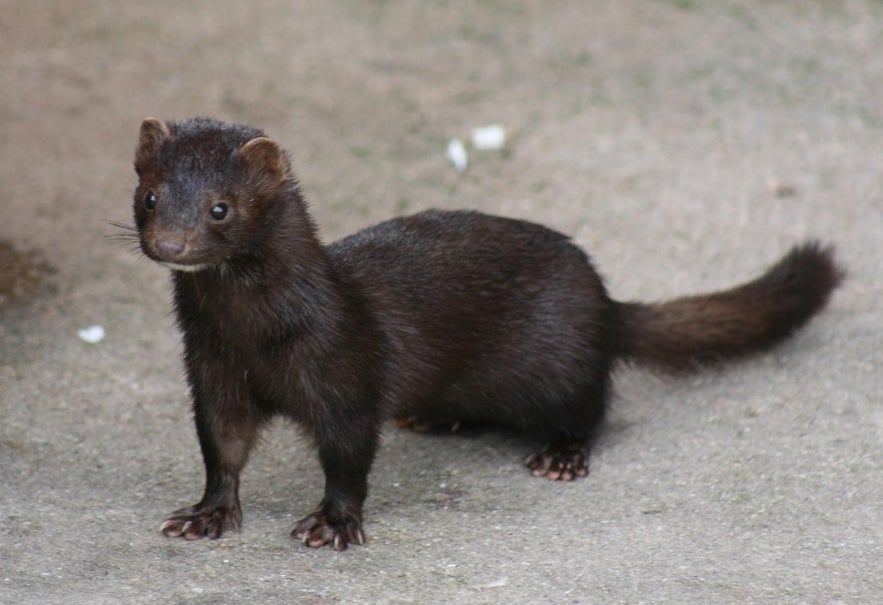
Throughout history, whenever humans discovered and settled new lands, they brought rodents with them, and Iceland is no exception. Along with wood and house mice, brown rats came over either with early settlers or later with trading ships and formed populations. The rats primarily live in populated areas, while the mice have spread all across the country.
Iceland also has a population of wild mink that was established more recently. They were imported for fur farms throughout the early 20th century but escaped and became feral. They’re often spotted fishing in the waterways around Reykjavik and hunting for bird eggs along nesting cliffs and have become the bane of chicken farmers across the country.
Rabbits are another invasive species and came even more recently than the mink. The majority of the rabbits are descendants of pets released around 2010. Now, they have spread across the country and wreak havoc wherever they go. In Oskjuhlid, a forested area in Reykjavik, they gnaw through tree roots and fences, damaging nature and human constructions alike.
Native Wildlife in Iceland
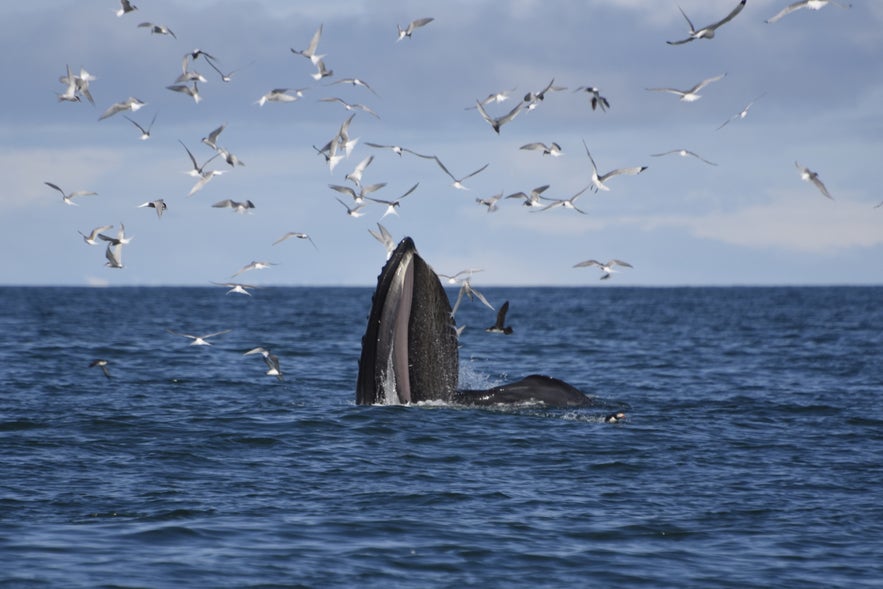
After reading this far, you might be wondering what animals are native to Iceland. As has been noted, Iceland has just one indigenous land mammal. However, that is not to say that the native wildlife of Iceland lacks diversity.
There’s a wealth of Iceland fauna in the country’s seas and skies, which draw visitors worldwide. It’s one of the best places to visit for bird watching, seal watching, and whale watching.
Arctic Foxes of Iceland
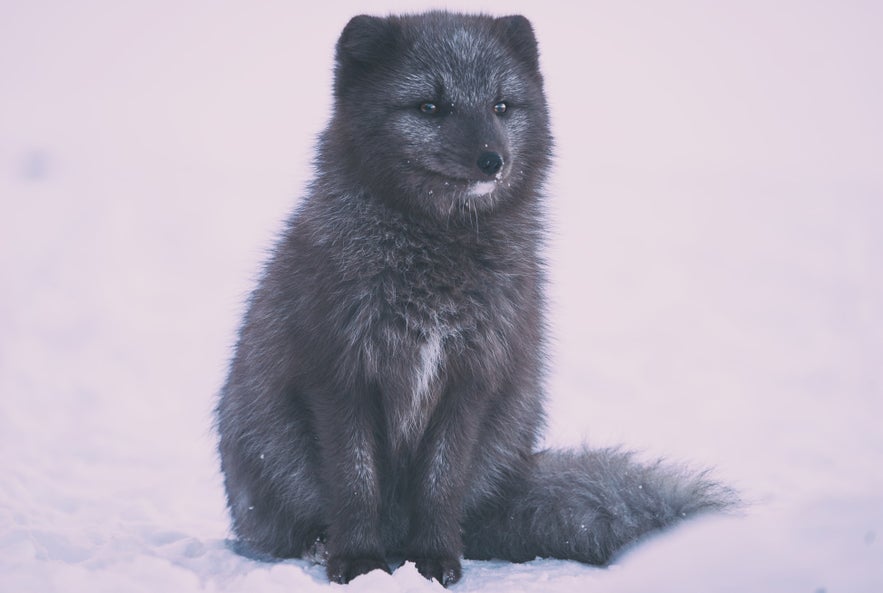 Photo by Jonatan Pie
Photo by Jonatan Pie
Before human settlement, the Arctic fox was the only land mammal that lived in Iceland. They walked over sea ice to the island during the last ice age, only to be stranded there when it melted over 10,000 years ago.
Incredibly adaptable creatures, they managed to sustain themselves by feeding on eggs, birds, invertebrates, and berries.
The foxes were hunted extensively for fur and livestock protection when humans arrived. With the development of fur farms, the former reason no longer applies, but farmers still maintain that population control is essential for their economy.
While hunting disrupted the fox populations, human arrival meant a wealth of new food in rodents, food waste, and lambs, allowing the species to survive.
 Photo by Jonatan Pie
Photo by Jonatan Pie
The Arctic foxes in Iceland come in two colors: white and blue. White foxes change their coat completely between seasons, going from snow-white in winter to brown and white in summer.
Blue foxes do not change coat, but their fur is bleached throughout summer so that they’re much lighter by the arrival of winter. However, both variants thicken their fur throughout the colder months and lose it when the weather warms.
Arctic foxes can be found across Iceland but are mainly concentrated in the Westfjords. There, you can find them in the very north of the remote Hornstrandir Reserve, where they’re protected. For those eager to spot an Arctic fox, options include booking a 10-hour or even a 3-day guided tour in Hornstrandir. They’re pretty fearless of humans in this region, so wildlife photographers often come for some very intimate shots.
Since 2007, there has been an Arctic Fox Center in the village of Sudavik. The center has led the way in researching these animals, educating people about their threats, and promoting eco-tourism.
Whales of Iceland
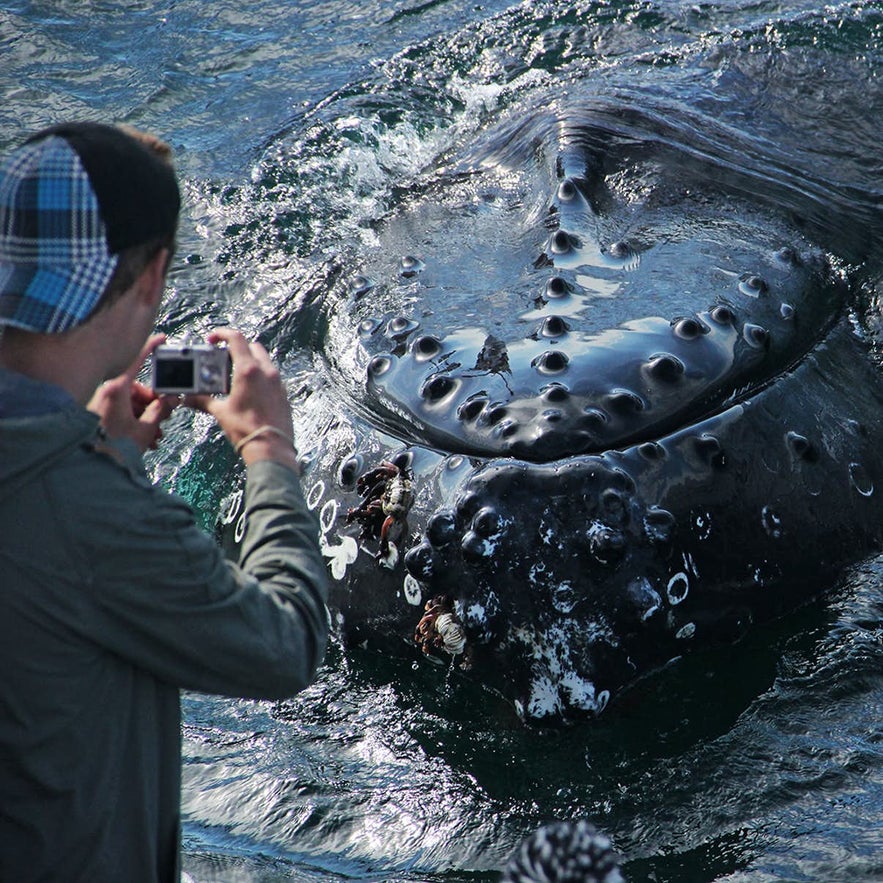 Picture from Húsavík Traditional Whale Watching
Picture from Húsavík Traditional Whale Watching
Iceland’s fertile sub-Arctic waters, fed by the Gulf Stream, are home to over 20 different whale and dolphin species.
It’s one of the best places in the world for whale watching, especially during the summer when the great whales migrate here to feed. With a variety of whale-watching tours available, you're sure to find one that suits your interests perfectly. This industry is changing how Icelanders view the creatures of the deep, as the relationship between the two is historical and complex.
As seafarers, many accounts from early Icelanders depict whales as terrible leviathans. An incredibly famous story tells of a warlock who attempted to take over Iceland by transforming into a whale before being rebuffed by a different guardian spirit on all four shores.
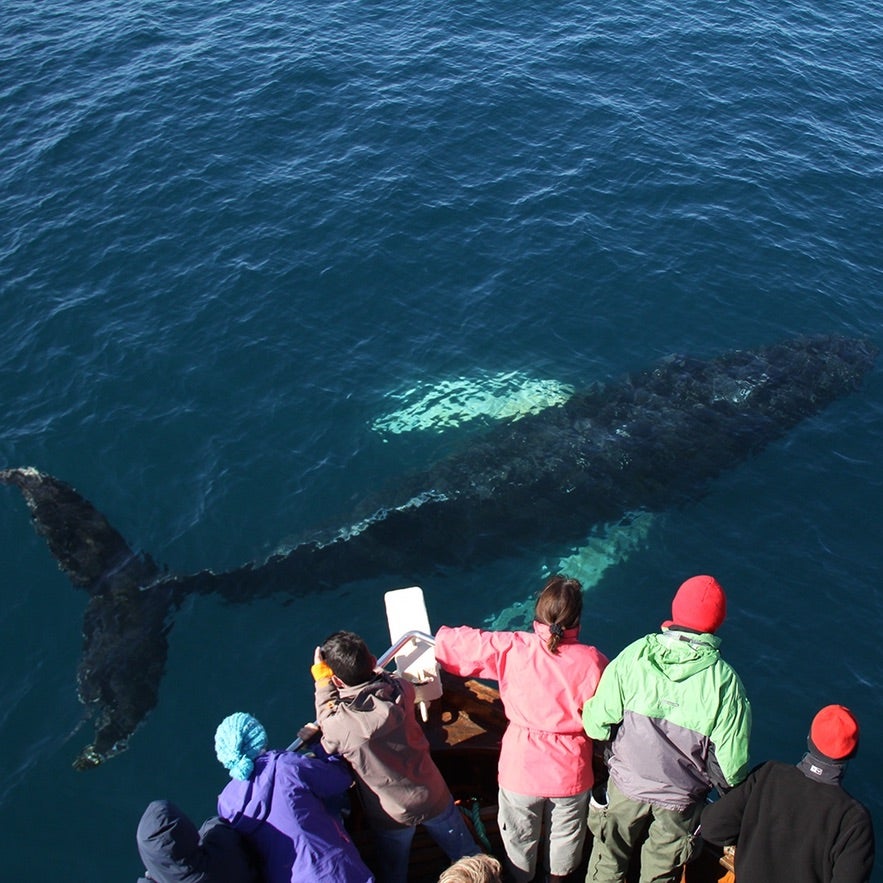
However, while feared when in their natural environment, whales were hugely appreciated when they washed up on the beaches.
The meat from a single stranding could feed communities, and their oil could supply candles and lanterns to help sustain people through the dark winters. The word for “windfall” in Icelandic is the same as a beached whale.
Iceland began commercial whaling in the late 19th century, later than most other nations, and struggled with the pressures against it for many decades. Commercial whaling has been outlawed then reinstated several times due to stock populations, international pressure, and local opinions.
While whaling continues today, it is a constant debate within the country about whether it has a future. What indeed does have a future, however, is whale watching. Tours are leaving from ports all across the country, with incredibly high success rates and a diverse wealth of life to see.
The best place to go whale watching is in Husavik, renowned for being the whale capital of Iceland. There’s a wide range of tours to choose from, such as this Family Run Whale Watching Tour in Husavik.
Seals of Iceland
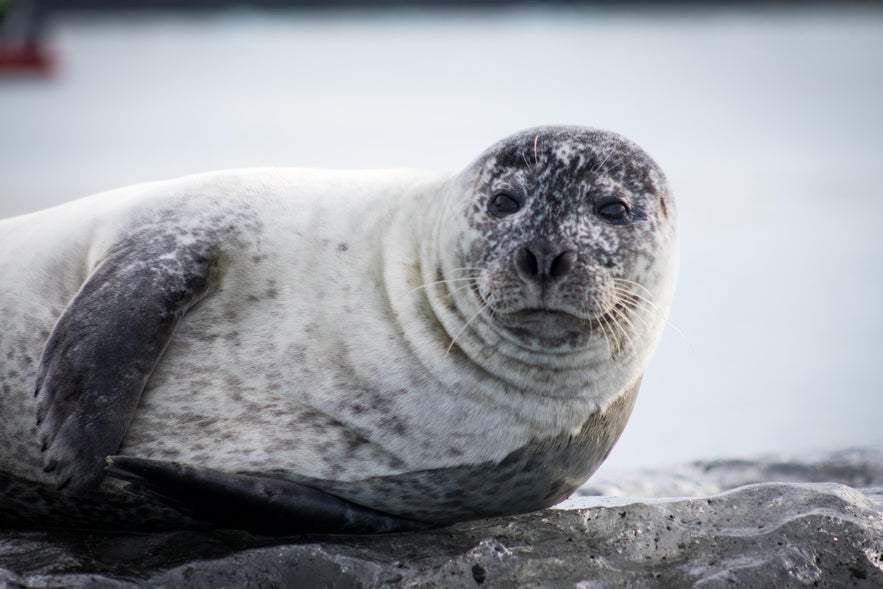 Photo by Jane Yeo
Photo by Jane Yeo
Seals have used Iceland’s shores as a place to haul out, breed, and shed for millenniums. Its cold, fertile waters and long stretches of rocky, uninhabited coast allowed large colonies to evolve before humans ever set foot here.
Their numbers and lack of fear of humans were a blessing when settlers did arrive. Seals provided the people with essential resources, from food to clothing to oil, which helped make the stark new country habitable.
Their populations were dwindling heavily by the 20th century when more and more were taken for fashion rather than necessity, but their numbers today are relatively stable.
 Photo by Einar Jonnson
Photo by Einar Jonnson
Seals are still hunted occasionally in Iceland due to their damage to fishing equipment and passing ringworm to fish stocks. Some are still hunted on private property for fur.
These practices have come under increasing examination as the seal-watching industry has boomed, especially since the opening of the Icelandic Seal Center in Hvammstangi, dedicated to researching these animals and raising awareness about their threats. You can visit the Seal Center's informative exhibition about this charming marine mammal while staying in accommodation in Hvammstangi.
Two seal species live permanently on Iceland’s shores: the harbor seal and the grey seal. They live all around Iceland, but the best places to spot them are the Westfjords, the Vatnsnes Peninsular, the Snaefellsnes Peninsula, and the Jokulsarlon glacier lagoon.
They’re not the only species to frequent Icelandic waters, however. Harp, bearded, hooded, and ringed seals are occasional visitors, and even walruses are sometimes seen in the Westfjords. Walruses used to have a large population here but were hunted to extinction in the 17th century.
- Learn more about Seals and Seal Watching in Iceland
Puffins of Iceland
Puffins are considered rare and elusive birds in most of the world, but there’s a wealth of them in Iceland. Their arrival in April and May marks the beginning of summer, and they can be easily seen up close in many parts of the country until August.
Approximately 60 percent of the world’s North Atlantic puffins breed in Iceland’s cliffs, and millions of nesting pairs exist. These birds do not like to roost anywhere where there are no others of their species, so wherever you can find one, you are likely to see hundreds more.
Puffins can be appreciated by boat and by land. From Reykjavik’s Old Harbor, it's easy to jump on an hour-long tour to one of two islands, Lundey and Akurey, just out in the bay, where they nest in the thousands.
These vessels are small enough to get close to the rocky shores, and many tours include binoculars so you can see them even more clearly. Many whale-watching tours also include a detour to these islands.
- Discover Where to Find Puffins in Iceland
Those traveling to the Westfjords need not even board a boat to see puffins in summer. The Latrabjarg cliffs, which are up to 1,444 feet (440 meters) high and stretch for 8.7 miles (14 kilometers), are impressive in their own right, but the wealth of birdlife makes them awe-inspiring.
Walking along the edge of this cliff makes it possible to get within arm’s length of the nesting puffins. They have no fear of people and will only fly off if someone tries to touch them. At such proximity, the details of their painted beaks and adorable expression are on clear display.
These are not the only places puffins nest, however. You can find them in huge populations around the Westman Islands, on the Dyrholaey rock arch, in Borgarfjordur Eystri, and Grimsey Island in the North.
As is well-documented, Icelanders have quite a penchant for unusual meats. Therefore, it's the only country in the world where you can spend the day watching puffins, then enjoy one for dinner.
Other Birds of Iceland
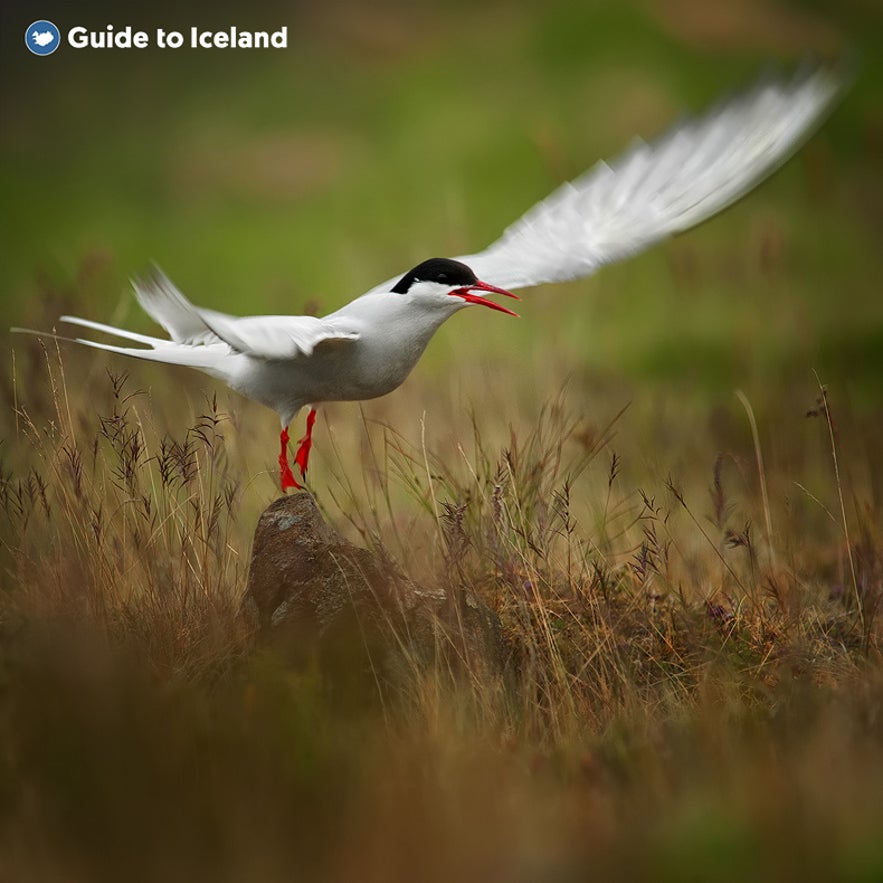
Puffins are the most popular bird in Iceland, but this tiny island has an enormous wealth of avian life.
The cliffs of Latrabjarg in the Westfjords and Krysuvikurbjarg on the Reykjanes Peninsula are home to thousands of individuals and many different species, such as guillemots, fulmar, gulls, auks, sandpipers, and peewits.
You can also find Arctic terns and sea eagles around the coasts. There’s an equal amount of diversity in freshwater; Myvatn Lake alone is home to 14 different duck species and geese and whooper swans.
Outside of aquatic environments, there are even more species: gyrfalcons, golden plovers, snipes, and ptarmigans all call the island home.
However, no discussion about the birds of Iceland would be complete without a mention of the raven. While this is one of the world’s most widespread animals, they’re ubiquitous here and revered for their intelligence and importance to Icelandic folklore and pagan beliefs.
- Learn more about The Birds of Iceland
Polar Bears from Greenland
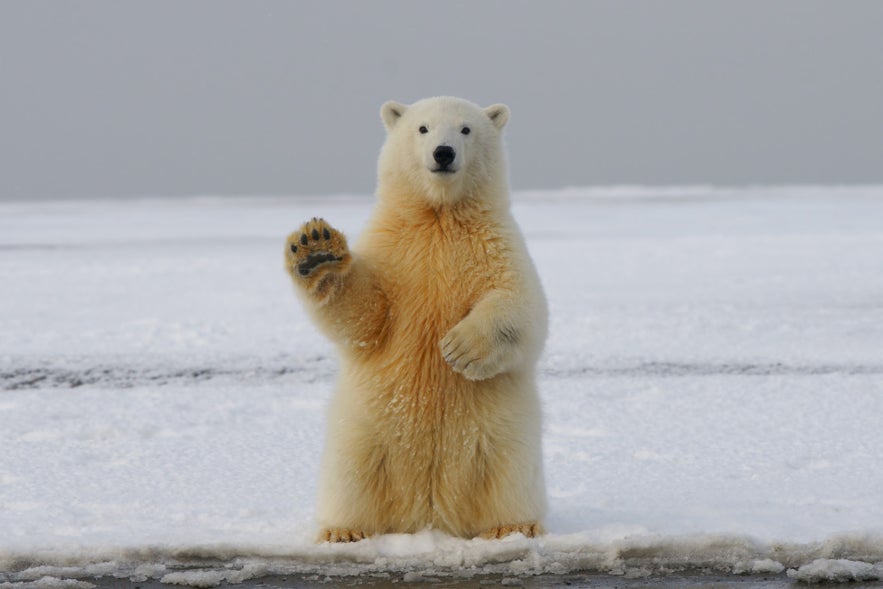 Photo by Hans-Jurgen Mager
Photo by Hans-Jurgen Mager
The polar bear is not one of the native Icelandic animals but an infrequent visitor from Greenland. Contrary to what many think, polar bears do not have a permanent population in Iceland. As the polar bear population has been steadily growing for the last few decades, they occasionally come from Greenland on ice-floes and land in the Westfjords.
Unfortunately, when they arrive, they’re likely to be starving and, therefore, pose a significant threat to those living in the region. Considering this and the cost of capturing, bringing to health, and returning the polar bear to its home (estimated at 85,000 USD), they’re killed upon arrival.
In just over a millennium, Iceland has come a long way from being a stark island with only one creature walking its land.
Now, if you travel through any part of the country, you’ll at least see a vast wealth of domestic life thriving in the harsh climate. You are likely to find much more if you know where to look. From the great whales to the runaway rodents, Iceland’s animals and wildlife are ever shaping this nation’s character.
If you’re in the capital area and want to see some domestic or wild animals, Reykjavik Family Park & Zoo could be a great choice for you. There you will find sheep, cattle, reindeers, arctic foxes, seals, and more.
Whether you’re interested in learning about Iceland’s wide variety of wildlife or the best places to spot the charming puffin, we hope this guide has helped you. We’d love to hear and respond to any comments or questions you may have in the section below.
Altri articoli rilevanti
Visitare l'Islanda a febbraio | La guida completa
Scopri tutto ciò che devi sapere sull'Islanda a febbraio. Guarda il tempo e capisci cosa mettere in valigia. Continua a leggere per sapere come prepararti per il viaggio, quali sono i tour e le atti...Leggi altro
La top 18 delle cose da fare e da vedere in Islanda
Trova le cose più belle da fare in Islanda e scopri dove andare e cosa vedere. Il paese spazia da bellezze naturali a esperienze culturali a gemme nascoste: scopri cosa puoi ammirare. Ci sono così...Leggi altro
Guida completa dell'Islanda ad agosto
Scopri tutto quello che c'è da sapere per visitare l'Islanda ad agosto in questa guida completa: quali animali selvatici si possono vedere, che tempo fa in Islanda ad agosto, quali siti vale la pena...Leggi altro

Scarica il più grande mercato di viaggi in Islanda sul telefono per gestire l'intero viaggio da un unico posto
Scansiona questo codice QR con la fotocamera del telefono e premi il link che compare per avere sempre in tasca il più grande mercato di viaggi in Islanda. Inserisci il numero di telefono o l'indirizzo e-mail per ricevere un SMS o un'e-mail con il link per il download.
